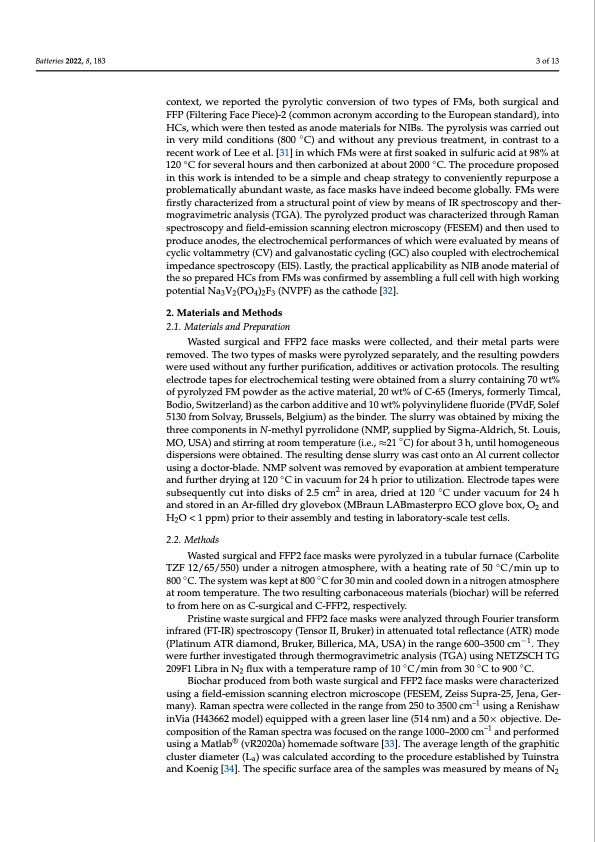
PDF Publication Title:
Text from PDF Page: 003
Batteries 2022, 8, 183 3 of 13 context, we reported the pyrolytic conversion of two types of FMs, both surgical and FFP (Filtering Face Piece)-2 (common acronym according to the European standard), into HCs, which were then tested as anode materials for NIBs. The pyrolysis was carried out in very mild conditions (800 ◦C) and without any previous treatment, in contrast to a recent work of Lee et al. [31] in which FMs were at first soaked in sulfuric acid at 98% at 120 ◦C for several hours and then carbonized at about 2000 ◦C. The procedure proposed in this work is intended to be a simple and cheap strategy to conveniently repurpose a problematically abundant waste, as face masks have indeed become globally. FMs were firstly characterized from a structural point of view by means of IR spectroscopy and ther- mogravimetric analysis (TGA). The pyrolyzed product was characterized through Raman spectroscopy and field-emission scanning electron microscopy (FESEM) and then used to produce anodes, the electrochemical performances of which were evaluated by means of cyclic voltammetry (CV) and galvanostatic cycling (GC) also coupled with electrochemical impedance spectroscopy (EIS). Lastly, the practical applicability as NIB anode material of the so prepared HCs from FMs was confirmed by assembling a full cell with high working potential Na3V2(PO4)2F3 (NVPF) as the cathode [32]. 2. Materials and Methods 2.1. Materials and Preparation Wasted surgical and FFP2 face masks were collected, and their metal parts were removed. The two types of masks were pyrolyzed separately, and the resulting powders were used without any further purification, additives or activation protocols. The resulting electrode tapes for electrochemical testing were obtained from a slurry containing 70 wt% of pyrolyzed FM powder as the active material, 20 wt% of C-65 (Imerys, formerly Timcal, Bodio, Switzerland) as the carbon additive and 10 wt% polyvinylidene fluoride (PVdF, Solef 5130 from Solvay, Brussels, Belgium) as the binder. The slurry was obtained by mixing the three components in N-methyl pyrrolidone (NMP, supplied by Sigma-Aldrich, St. Louis, MO, USA) and stirring at room temperature (i.e., ≈21 ◦C) for about 3 h, until homogeneous dispersions were obtained. The resulting dense slurry was cast onto an Al current collector using a doctor-blade. NMP solvent was removed by evaporation at ambient temperature and further drying at 120 ◦C in vacuum for 24 h prior to utilization. Electrode tapes were subsequently cut into disks of 2.5 cm2 in area, dried at 120 ◦C under vacuum for 24 h and stored in an Ar-filled dry glovebox (MBraun LABmasterpro ECO glove box, O2 and H2O < 1 ppm) prior to their assembly and testing in laboratory-scale test cells. 2.2. Methods Wasted surgical and FFP2 face masks were pyrolyzed in a tubular furnace (Carbolite TZF 12/65/550) under a nitrogen atmosphere, with a heating rate of 50 ◦C/min up to 800 ◦C. The system was kept at 800 ◦C for 30 min and cooled down in a nitrogen atmosphere at room temperature. The two resulting carbonaceous materials (biochar) will be referred to from here on as C-surgical and C-FFP2, respectively. Pristine waste surgical and FFP2 face masks were analyzed through Fourier transform infrared (FT-IR) spectroscopy (Tensor II, Bruker) in attenuated total reflectance (ATR) mode (Platinum ATR diamond, Bruker, Billerica, MA, USA) in the range 600–3500 cm−1. They were further investigated through thermogravimetric analysis (TGA) using NETZSCH TG 209F1 Libra in N2 flux with a temperature ramp of 10 ◦C/min from 30 ◦C to 900 ◦C. Biochar produced from both waste surgical and FFP2 face masks were characterized using a field-emission scanning electron microscope (FESEM, Zeiss Supra-25, Jena, Ger- many). Raman spectra were collected in the range from 250 to 3500 cm–1 using a Renishaw inVia (H43662 model) equipped with a green laser line (514 nm) and a 50× objective. De- composition of the Raman spectra was focused on the range 1000–2000 cm–1 and performed using a Matlab® (vR2020a) homemade software [33]. The average length of the graphitic cluster diameter (La) was calculated according to the procedure established by Tuinstra and Koenig [34]. The specific surface area of the samples was measured by means of N2PDF Image | From Wastes to Anode Materials for Na-Ion Batteries

PDF Search Title:
From Wastes to Anode Materials for Na-Ion BatteriesOriginal File Name Searched:
batteries-08-00183.pdfDIY PDF Search: Google It | Yahoo | Bing
Salgenx Redox Flow Battery Technology: Salt water flow battery technology with low cost and great energy density that can be used for power storage and thermal storage. Let us de-risk your production using our license. Our aqueous flow battery is less cost than Tesla Megapack and available faster. Redox flow battery. No membrane needed like with Vanadium, or Bromine. Salgenx flow battery
| CONTACT TEL: 608-238-6001 Email: greg@salgenx.com | RSS | AMP |